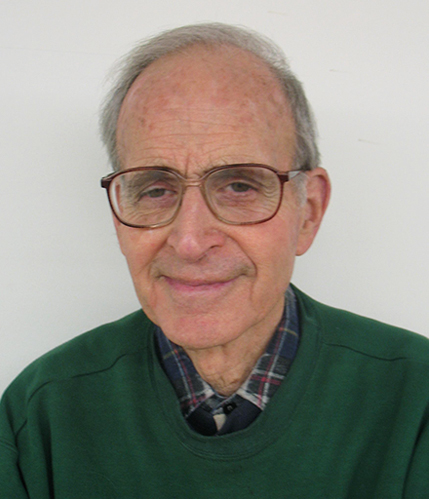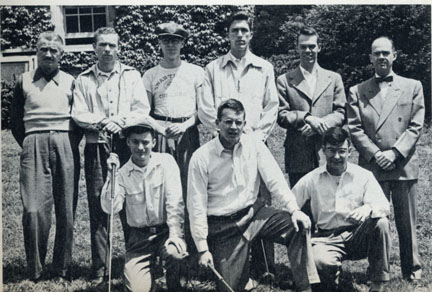Teeing Off
Halcyon days with clubs in hand.
Turning the pages of the Bulletin as I always do, I suddenly see some young men and women looking just like young golfers. Yes, young tigers ready to go after par on any occasion. Swarthmore golfers. Amazing.
I was a Swarthmore golfer. Back around 1950. Things sure have changed since then. For me it all started in my hometown of Chillicothe, Ohio. My father was a member of the local country club, and I was a caddy for several years. I played some golf—taught myself with a book of big photos showing Slammin’ Sammy Snead hitting shots with wondrous and immaculate smoothness.
So when I arrived at Swarthmore in September 1949, I poked around and found that we had a golf team and asked if I could join. “Sure,” I was told. “Most of our players graduated last year, and we’re looking for people who’d like to play. So you’re on the team—but there’s nothing to do now. We’ll talk about it sometime next March.”
March arrived. I’d brought my clubs with me after spring break. Our coach wasn’t actually a coach. He lived in Wilmington and drove up every Thursday and escorted us to the golf course at nearby Rolling Green Country Club.
Our mentor did no coaching. His job was to pay the fees for our rounds. We’d tee off and play, and he and a friend would follow the last foursome to make sure we all got around.
On days when we had matches with other teams, he’d hand us each two balls for the day’s contest, then make his usual round with his buddy.
At Rolling Green that spring, we played around the course, hitting the ball as best we could and delighting in the gorgeous blossoms on trees and shrubs. Then, once a week, we’d play a match, either at home or away. I really don’t remember how we did, but for sure we were not Ryder Cup material. So what? There were no spectators to please, no big hotshots on our team. We were content to just get in a few good shots and a long putt or two.
We learned that the Philadelphia area had a fine array of golf courses and that some memorable golfing moments had taken place on them.
In 1938, the U.S. Open came to the Philadelphia Country Club, and my own Sam Snead was in the groove. The last round came, then the last hole, and Sam was leading the pack. But somehow, he’d gotten it into his head that the final hole was a par 5. So when his drive and second shot both went astray, he told his caddy not to worry because he still had three more shots in which to make par. The caddy broke the news: This is a par 4 hole. This revelation messed up Sam’s concentration, and he ended up shooting an 8, losing to “Lord” Byron Nelson—another great of the era.
Sam went on to win a record 82 P.G.A. tournaments. But he never won the biggest of all, that elusive U.S. Open.
Then, in 1950, there was Ben Hogan at the nearby Merion Golf Club.
Months earlier, on a dark and foggy late afternoon, Hogan and his wife were driving from one tournament to another when a bus trying to pass an 18-wheeler came out of the fog and struck Ben’s car head on. He had time to jump to his right to protect his wife, and that saved his life—the steering column went right through the driver’s seat.
Hogan’s slow recovery from serious injuries was accompanied by a mammoth determination to play again. His hope was to show everyone that, despite the crash, Ben Hogan would not give up. As it happened, the 1950 Open—the one he wanted most to win—would be played at Merion in Philadelphia. That meant two days with 18 holes both morning and afternoon—taxing a body still far from fully healed.
Cheered on by a big crowd, Ben played the four rounds—and at the end was tied with two other players, which meant 18 more holes the next day for his battered body. All walking of course.
He arrived at the 18th tee with a good chance to win. If he could shoot a par 4, he would be the champion. Eager onlookers filled the rough on both sides of the fairway, hoping to cheer.
Hogan’s drive was straight down the middle, but the flag was still 180 yards away. He pulled out his 1 iron (not used any more because the club face is almost vertical and too difficult to handle) and hit his ball close to the pin. To full-throated cheers from the crowd, he sank the putt that made him the winner. Everyone knew about his accident and his fight to come back. It was a perfect finish. (View a painting of Hogan’s shot).
We were no Sneads or Hogans, but we Swatters loved being outside on a beautiful day with clubs in hand. We got to play on four or five excellent courses for nothing. What did a few numbers scribbled on a scorecard mean? Not a whole lot. Sometimes we’d get a bit down about not coming all that close to par, but such are the ways of the game.
Enough of the past. Let’s move on. Clearly, Swarthmore and its student players have done a lot over the years to bring golf right up there with the field-hockey stickers and soccer kickers and basket-ballers and pool-board divers and softball clouters and lacrosse stickers and tennis racketeers.
Now, there is a his team and a her team, and they get to play much longer than we did. Autumn allows a couple of matches and ends with a Swarthmore Fall Tournament. Winter is for weightlifting. In February, drivers, irons, and putters swing into action if the usually dismal weather gives way to an almost pleasant spell.
March brings spring break and a trip to awesome Pinehurst, N.C., and its fabled course. Then back to home matches against teams including Muhlenberg, Ursinus, and Gettysburg—and finally the Centennial Conference championships. The winning teams (both male and female) get to take part in an NCAA tournament. Coach Jim Heller has high hopes for both Swat teams this spring.
Are today’s boomers and swishers better than we were? Of course. The best can shoot in the 70s, when all is going right. Our best rarely got below 80, and high 80s was considered quite adequate for who we were and how we played. Our modern compatriots, armed with much better equipment, are shooting scores that we could reach only in our dreams back in the early 1950s. I’m giving an imaginary shake to all their golf-loving hands and hope they keep on moving smoothly into par-land—and below.
PS: During a phone conversation, Coach Heller asked if I remembered the 14th hole at Rolling Green. Oh boy, the mere sound made my fingers flutter. The tee on high ground; waiting far in the distance, the green on high ground. In between the sand canyon (well, not quite sand). Hit short and you stand doomed as the ball drops irrevocably into the pit of desperation. Indeed, I remember—my howl of disbelief and all the wild whacks that followed.

Ted Hoey
Ted Hoey ’52 was born in Chillicothe, Ohio, where he grew up in what he calls “a kind of Tom Sawyer atmosphere” with his parents and two brothers. After “surviving” four years “among the whirling brains and bubbling talents” at Swarthmore, he spent time in the Army; then as a teacher on Long Island, N.Y.; followed by 40 years in the publishing business as a writer and editor for secondary education publications.
 Email This Page
Email This Page
